Euphorbia clandestina
Euphorbia clandestina Jacq.
Family: Euphorbiaceae
Common names: ostrich neck (Eng.); volstruisnek (Afr.)
Introduction
Euphorbia clandestina is a fascinating species with a single, cylindrical, warty stem with a tuft of leaves at the tip, and is both succulent and herbaceous, making it an an exceptional indoor and outdoor plant. When smaller it makes an excellent potted plant, while larger plants are appreciated landscaping plants. It is also known by some as ‘the soldier’ and it lives up to this name by standing up straight, as if at attention, as a single-stemmed plant or only rarely branching with age.
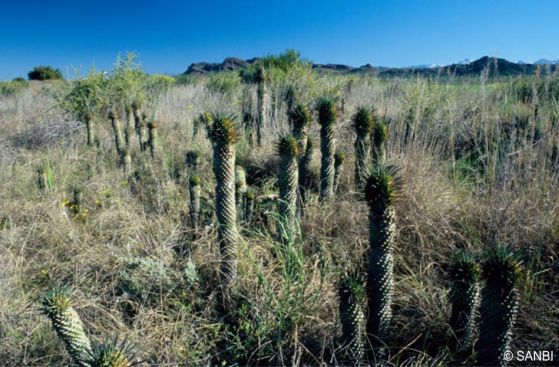
Description
Description
Euphorbia clandestina is an upright-growing succulent shrub. It is typically a single-stemmed evergreen plant but can become multi-stemmed over time. The stem can reach a height of up to 800 mm and a diameter of up to 50 mm, and can occasionally form branches. The leaves are green to bluish-green, linear-lanceolate, strongly keeled (folded along the midrib), minutely hairy, and grow up to 60 mm long and about 4 mm wide. The stems have several spiralling rows of tubercles (nodule-like protrusions), and each tubercle is tipped with a leaf near the growing tip of the stem. The stems are naturally green and can turn attractive shades of reddish to purple in winter. In older plants, the base of the stem becomes light brown with age.
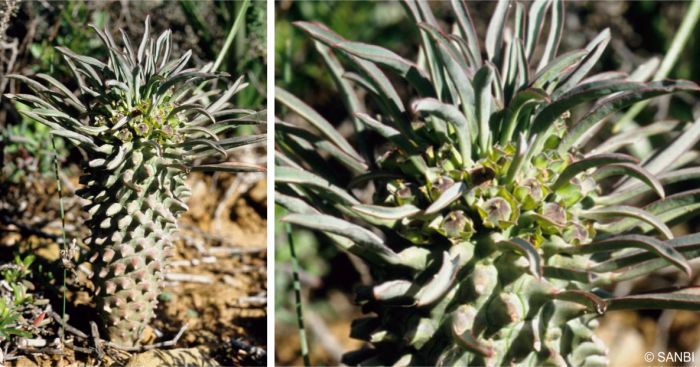
Euphorbias produce unique flower structures, which are not typical flowers but reduced inflorescences called cyathia. The cyathia of Euphorbia clandestina appear in winter and spring (June-Sept.) and are small and unnoticeable and nearly hidden among the leaves and tubercles. They are solitary, sessile (without a stalk), pale yellow and closely surrounded by several bracts, which create a visually attractive presentation when in flower. The cyathia of Euphorbia clandestina are distinctive because they are stalkless, and this makes the species easily identifiable,with no confusion, when compared to the other succulent euphorbias, or the closely related species, Euphorbia clava which has cyathia on stalks up to 60 mm long.
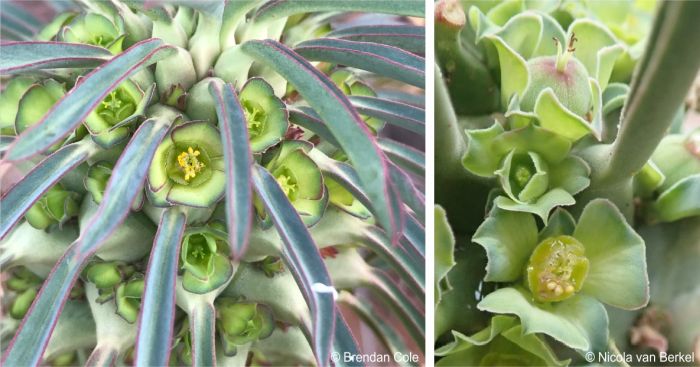
Conservation Status
Status
According to the Red List of South African Plants, Euphorbia clandestina Jacq. is considered not threatened and is assessed as Least Concern (LC). It is a South African endemic species, that occurs naturally only in the Western Cape of South Africa.
Distribution and habitat
Distribution description
Euphorbia clandestina, which habitually occurs on rocky hills and stony lower slopes, between low shrubs and in karroid scrub, is native to South Africa, and its distribution ranges between Robertson, Swellendam, Oudtshoorn, Uniondale, Albertinia and De Hoop in the Western Cape Province. This region has a subtropical climate with a cool, rainy winter and a hot, dry summer. It thrives in well-draining soils and can survive in several environmental conditions, such as full sun to semi-shade, heat and drought. The species is sometimes found in rocky or disturbed areas, where it can easily establish itself amongst other plants.
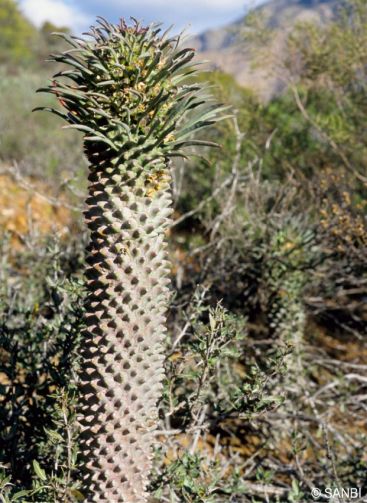
Derivation of name and historical aspects
History
Euphorbia clandestina was described by Jacquin in 1804, as a secretive euphorb that is not easily confused with any other Euphorbia species. The species name clandestina, is a Latin word which means ‘hidden’, ‘secret’ or ‘concealed’, referring to the flowers that are hidden among the leaves. Its common Afrikaans name volstruisnek, meaning the ‘neck of an ostrich’, refers to its upright and cylindrical stem.
The species comes from the Euphorbiaceae, also known as the spurge family, which is a large family consisting of more than 7 500 species and some of the most diverse genera of flowering plants in the world. The plants in this family may be herbs, shrubs, or trees, herbaceous, woody, or succulent, and are mostly characterized by noticeable milky latex.
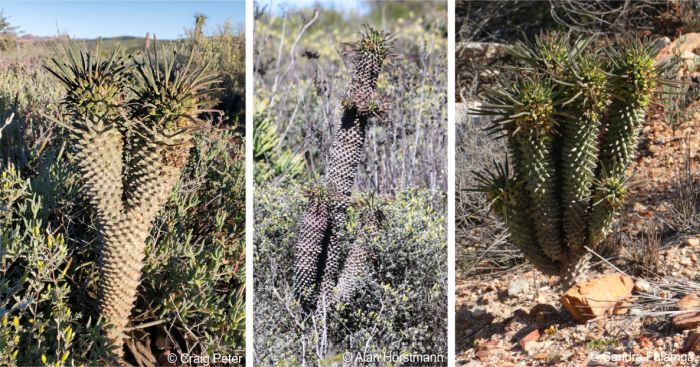
Ecology
Ecology
One of the significant aspects of Euphorbia clandestina is its ecological role. This species can often be found in disturbed habitats such as road-sides. By occupying these places, Euphorbia clandestina not only helps prevent soil erosion but also contributes to the stabilization of the local ecosystem. Additionally, it plays a part in nutrient cycling within the soil. Its root system helps in aeration and allows for the breakdown of organic matter, thereby enriching the soil. The succulent nature of this species enables it to survive adverse environmental conditions, particularly those with limited water. Its ability to absorb and store water is crucial for this species as it allows it to withstand periods of drought or water scarcity by storing water and nutrients, enabling it to thrive where other plants are less able to survive. The ability of Euphorbia clandestina to withstand diverse environmental conditions makes it a critical species as climate change continues to alter ecosystems worldwide. Following its flowering season, the plant produces seeds that are dispersed by being flung from the seed capsule that opens explosively when it is ripe, and the seeds may be carried further by rain water runoff, promoting reproduction.
Uses
Use
Euphorbia clandestina is used ornamentally as a striking succulent plant, popular for succulent gardens and xeriscaping and is ideal for water-wise karoo, renosterveld and fynbos gardens. In some cultures, it may be used in traditional medicine, and the sap of some species is being studied for potential anticancer properties.
The species produces a toxic white milky sap that can cause irritation to the skin and eyes, hence it is recommended to keep it away from children and animals.
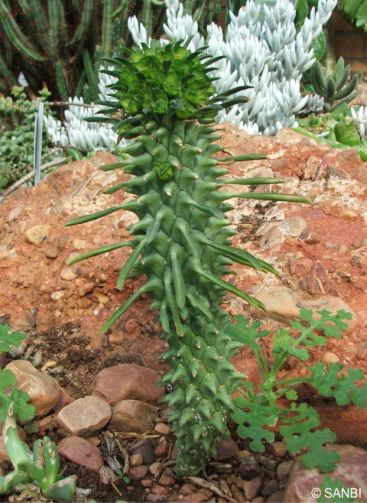
Growing Euphorbia clandestina
Grow
Euphorbia clandestina is a hardy landscape plant that is rarely seen in its habitat but well established in cultivation and very easy to grow. Some older plants of this species need support or one may allow the plant to lean over and grow along the ground. Plants set seed readily and young seedlings can be easily transplanted.
Grow as a pot plant and also an outdoor plant in well-drained soil to prevent root rot. It does well in a container located in a sunny position like a windowsill or verandah. When grown as an outdoor plant, grow it in a dry succulent garden, in a position in full sun to semi-shade with protection from frost. The plant can tolerate high summer temperatures but suffers from low winter temperatures.
The flowers of this species are self-fertile and regularly sets seed on its own. Propagate the species from sowing its seeds in spring, which are said not to be that easy to germinate. Use a well-drained sowing medium and keep the seeds warm and moist. Also, propagate through cuttings taken in spring or early summer. Allow the cut stem to dry for a few days to form a callus, plant in gritty sand, or well-drained loamy potting soil and keep in a cool, damp, semi-shaded and well-ventilated spot until rooted.
Just like most other succulent plants known for their water storage capability, Euphorbia clandestina watering should be done infrequently, allowing the soil to dry out in between waterings. Only water when the soil is completely dry, to prevent root rot. Water potted plants deeply until surplus water drains out, then allow the soil to dry out before watering again. In their natural arid environment, watering should be reduced in winter but rather give the plants just enough needed water to avoid wilting.
Unlike plants grown directly in the ground, Euphorbia clandestina plants grown in containers need regular feeding, as they are not able to access nutrients from the surrounding soil as nutrients contained by potting mixture may deplete after some time with watering.
References
- Archer, R. 2005. Euphorbia L. (Euphorbiaceae). PlantZAfrica. Internet. http://pza.sanbi.org/euphorbia
- Cole, B. 2022-Apr. Observation of Euphorbia clandestina, Paardepoort West, WC. iNaturalist. https://www.inaturalist.org/observations/112513328.
- Falanga, S. 2020-Oct Observation of Euphorbia clandestina, Robinson Pass, WC. iNaturalist. https://www.inaturalist.org/observations/66651498
- Horstmann, A. 2018-Oct. Observation of Euphorbia clandestina, Montagu, WC. iNaturalist. https://www.inaturalist.org/observations/17859786
- iNaturalist. Spurge Family (Family Euphorbiaceae). https://www.inaturalist.org/taxa/51821-Euphorbiaceae. Accessed 23 June 2025.
- Manning, J. & Goldblatt, P. 2012. Plants of the Greater Cape Floristic Region 1: the Core Cape Flora. Strelitzia 29. South African National Biodiversity Institute, Pretoria.
- Peter, C. 2017-Aug. Observation of Euphorbia clandestina, Oudtshoorn district, WC. iNaturalist. https://www.inaturalist.org/observations/236222997.
- Raimondo, D., Von Staden, L., Foden, W., Victor, J.E., Helme, N.A., Turner, R.C., Kamundi, D.A. & Manyama, P.A. (eds) 2009. Red list of South African plants. Strelitzia 25. South African National Biodiversity Institute, Pretoria.
- Rowley, G., Holmes, S.C. & Mitich, L. 1983. Euphorbia clandestina. The Euphorbia Journal Volume 1: 63.
- Rowley, G., Holmes, S.C. & Mitich, L. 1984. Euphorbia clandestina. The Euphorbia Journal Volume 2: 41.
- SANBI. Kirstenbosch Conservatory: Little Karoo Bed. https://www.sanbi.org/gardens/kirstenboch/seasons/botanical-society-conservatory/kirstenbosch-conservatory-little-karoo-bed/. Accessed 23/06/25.
- Seeds and All. Euphorbia clandestina. https://seedsandall.co.za/product/volstruisnek-euphorbia-ostrich-neck-euphorbia-euphorbia-clandestina-5-seed-pack/. Accessed 23 June 2025.
- Van Berkel, N. 2019-Apr. Observation of Euphorbia clandestina, Montagu, WC. iNaturalist. https://www.inaturalist.org/observations/22771943.
- White, A., Dyer, R.A. & Sloane, B.L. 1941. The succulent Euphorbieae (southern Africa). Volume 1 & 2. Abbey Garden Press, California.
- World of Succulents. Euphorbia clandestina (Ostrich Neck). https://worldofsucculents.com/euphorbia-clandestina-ostrich-neck/. Accessed 23 June 2025.
Credits
Sihle Nqentsu
Pretoria National Botanical Garden
July 2025
Acknowledgements: close-up images of the cyathia by Brendan Cole and Nicola van Berkel; images of branched plants by Craig Peter, Alan Horstmann and Sandra Falanga.
Plant Attributes:
Plant Type: Succulent
SA Distribution: Western Cape
Soil type: Sandy, Loam
Flowering season: Spring, Winter
PH: Acid, Neutral
Flower colour: Green, Yellow
Aspect: Full Sun
Gardening skill: Easy
Special Features:
Horticultural zones








Rate this article
Article well written and informative
Rate this plant
Is this an interesting plant?
Login to add your Comment
Back to topNot registered yet? Click here to register.